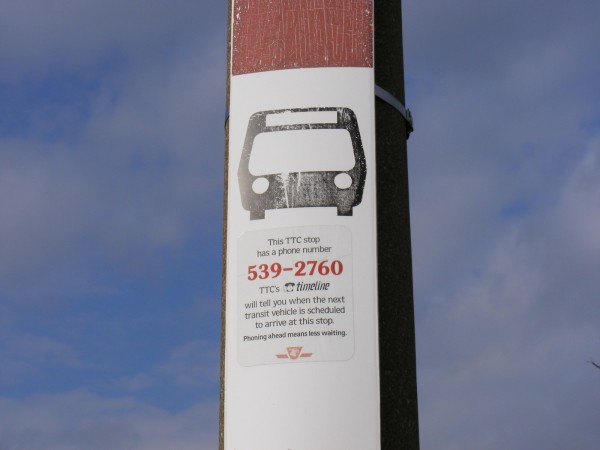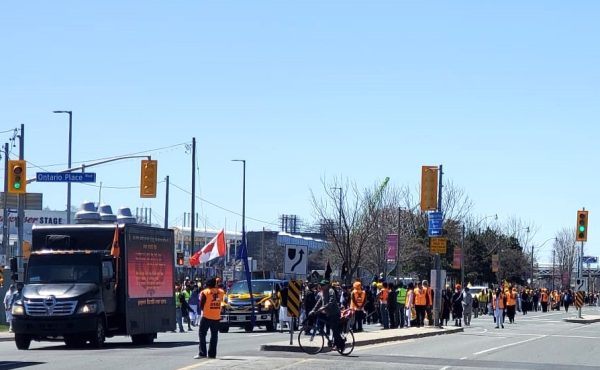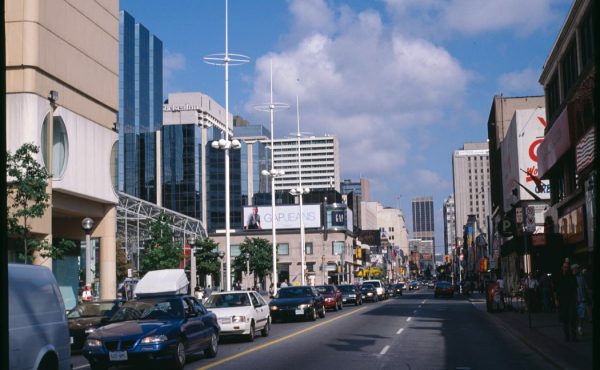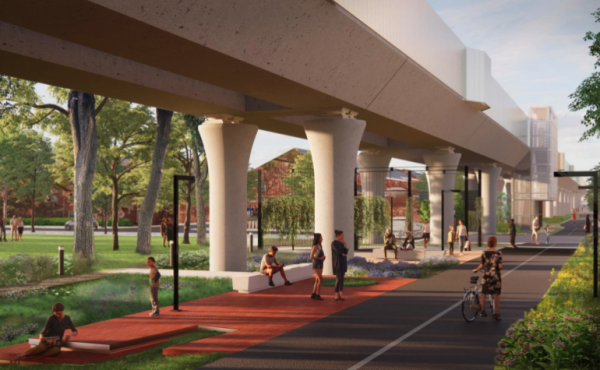At the next Toronto Transit Commission meeting on January 28, staff will present a report [PDF] that may affect the locations of bus and streetcar stops across the city.
The first recommended principle outlined in the report is to locate stops at traffic signals and pedestrian crossovers where possible; the second is to reduce the number of stops where they are currently closely located, such as in the downtown core. Thirty-nine Sunday-only stops, mostly found in the old City of Toronto are also proposed for removal.
TTC staff note that traffic signals and pedestrian crossings are generally the best locations for stops for consistency and for pedestrian safety; some stops are too far from designated crossings. TTC staff are also advocating a 300-400 metre standard distance between transit stops; they consider it the right balance of convenience and speed. (Though there are exceptions that are mentioned in the report.)
While a planned review of the more than 10,000 surface stop locations is taking place system-wide, the five page report provides a specific example of the TTC’s proposed stop rationalizations – Queen Street between Church Street and Spadina Avenue. On this stretch of Queen, the distance between stops range from a mere 90 metres (the distance between Victoria and Yonge Streets) to 285 metres. Stops at Victoria, York and McCaul Streets would be removed in both directions. Consistent with the goal of moving stops closer to traffic signals, the westbound Simcoe stop would be moved to the lights at St. Patrick Street. Staff will report back at the next monthly meeting in February with a follow-up report and specific plans to consult with local city councillors on proposed stop relocations and removals.
Sunday stops are, at least in my opinion, a quaint reminder of “Toronto the Good” and the TTC is right to phase these out. Some stop rationalization is necessary given the arrival of new, 28-metre long streetcars offering all-door boarding. It is also good to see the TTC developing a specific policy for the location of transit stops. There will certainly be some opposition to removing specific local stops, so it will be seen how far the TTC gets in implementing this plan.
Another report to be presented at the January 28 meeting discusses time-based transfers, such as those provided by most suburban transit agencies such as Brampton, Mississauga and York Region (and on St. Clair Avenue, part of a seemingly never-ending pilot project). If implemented, the new transfer policy would coincide with the system-wide Presto Card rollout in 2015. The TTC estimates implementing a 2-hour transfer (the same time allowed in the 905) would cost $20 million in lost fare revenue each year, though the proposal is acknowledged as popular and “positive for both customers and employees.” The report only recommends further study on the logistics and financial implications of a time-based transfer, and the elimination of the St. Clair pilot if a timed transfer is not adpoted in 2015.





11 comments
Would be better if they shifted some of the near-side stops to far-side stops. However, they way they implemented transit priority (NOT!), the streetcars would still have to wait for a red before moving to the far-side stop.
What they really need too is to get rid of the twin stops that are on opposite ends of intersections. If someone could please enlighten me on why these exist? I can’t tell you the number of times I’ve been late because of East Side Stop and West Side Stop Weston Road at Lawrence Avenue West. Or another example being East and West Side Stop Kennedy Road at Steeles Avenue East.
Miguel: This might happen. I recently noticed that the near-side stop at for the southbound 7 bus at Bathurst and Wilson was removed, with a notice stating that it was removed to accomodate the new articulated buses now being deployed on Bathurst and as part of a system-wide review of all surface stops.
Having both near and far side bus stops is convenient for those making transfers at that intersection, inconsistent as to what intersections they are located.
Although it is not mentioned in the staff report, the other big factor that is driving the stop review process is the fact that there will need to be sidewalk work undertaken at each stop to make it accessible. The Kingston Road reconstruction that was completed this past fall built this in — a lowered sidewalk with tactile plates at each stop — but I don’t believe it has been done anywhere else on the network. If there was any possibility that you might want to review stop locations, now is the time to do it, before you expend the time and money to retrofit sidewalks for a stop that will end up being abandoned by the time the new streetcars start service.
The strangest Sunday stop I’m aware of is on College between Elizabeth and Queen’s Park Station. I believe the church whose parish it once served has been taken over by U of T and serves as the main office for their nursing program (150 College).
Still, every Sunday, all day long, the streetcars dutifully stop there, the lady calls the stop… no one gets on, no one gets off, and the trolley rumbles on to Queens Park station maybe 50 metres away.
Quaint isn’t the right word… It’s more like a memorial.
yay! Finally the TTC is actually following it’s own guidelines of 300 meters. I remember arguing with Adam Giambrone that stops 15 seconds/100M apart were much too close. He indicated the standard was 300 meters which I replied as exactly my point, the TTC isn’t following their own prescribed standards. This is long, long overdue.
I think the longest “never-ending” pilot project is the POP (Proof of Payment) system. This allows you to board by the rear doors if you have a valid transfer or pass. It’s the system on the Queen cars, and on a few other streetcars–but only for the part of their route on Queen Street. And it only happens between 7 am and 7 pm. When it was started, the idea was to roll it out to all streetcars, but that, of course, never happened, for reasons that have never been made clear to me, beyond the TTC’s general inability to follow through on pilots.* I don’t think half the passengers even know it exists. And I have never, ever seen any TTC employees checking to see if people are boarding with the proper fare. Essentially, riding on the Queen car has been free for more than 20 years.
* There was also a pilot to brand the Yonge-University-Spadina Line as the Yellow Line and the Bloor Line as the Green Line. The pilot was instituted at St George station, and the yellow and green signage can still be seen on the platform walls and on a signs in front of the St. George and Bedford entrances, but it was quickly forgotten. I laugh at it now that the TTC is thinking about renaming the subway lines with numbers. They’ll probably start with line 3 and never get to 1, 2 or 4.
I think this is a great move. There are lots of stops that are just too short a walk to bother with. The first one I think of is Empire Ave ( I think ), which is the stop just before Logan heading east on Queen. It is so close to Logan, which is already busy, and I think if you can manage to walk a block or two to your home, you can manage the extra 100meters to the Logan stop. If all these lesser used stops were taken away I think the street car would be way faster.
What confuses me is the TTC say they lose up to $14 million a year on transfer fraud, surely part of the $20 million loss of timed transfers would be offset by less fraud since folks won’t have as many excuses to try and cheat the system.
The TTC report is light on specifics. It doesn’t say by how many minutes the stop removals will speed up the Queen car’s running time. The answer is likely zero. The TTC’s operating policy is streetcars come to a complete stop at every set of points (where the streetcar can go straight or turn). There are points both ways at Victoria, same for McCaul. Streetcars will stop at both of those, whether there are passenger stops there or not.
However: benefits for cars! “TTC staff were part of the work team, established by the City’s Transportation Services, to identify means to reduce congestion and improve traffic flows in the downtown area. The issue of very closely-spaced streetcar stops was identified as a problem that contributes to congestion on downtown roadways: when a streetcar is serving a transit stop, all traffic travelling in the same direction must stop, even at a green light. Removal of closely-spaced stops would provide City staff with greater flexibility in their efforts to improve traffic flow on downtown streets.”
I also wonder if they actually did any kind of study on the safety of stops at signalized intersections versus not. So many pedestrian fatalities happen at signalized intersections and a pedestrian is crossing with the light, and gets hit by a turning vehicle.
“A 300-400 metre standard distance between transit stops” still seems rather close together. Consider the people who live along the Bloor/Danforth subway. Here are some distances, courtesy of Google Maps:
Bathurst to Christie 601 m
Christie to Ossington 611 m
Ossigton to Dufferin 821 m
Dufferin to Lansdowne 622 m
Lansdowne to Dundas West 814 m